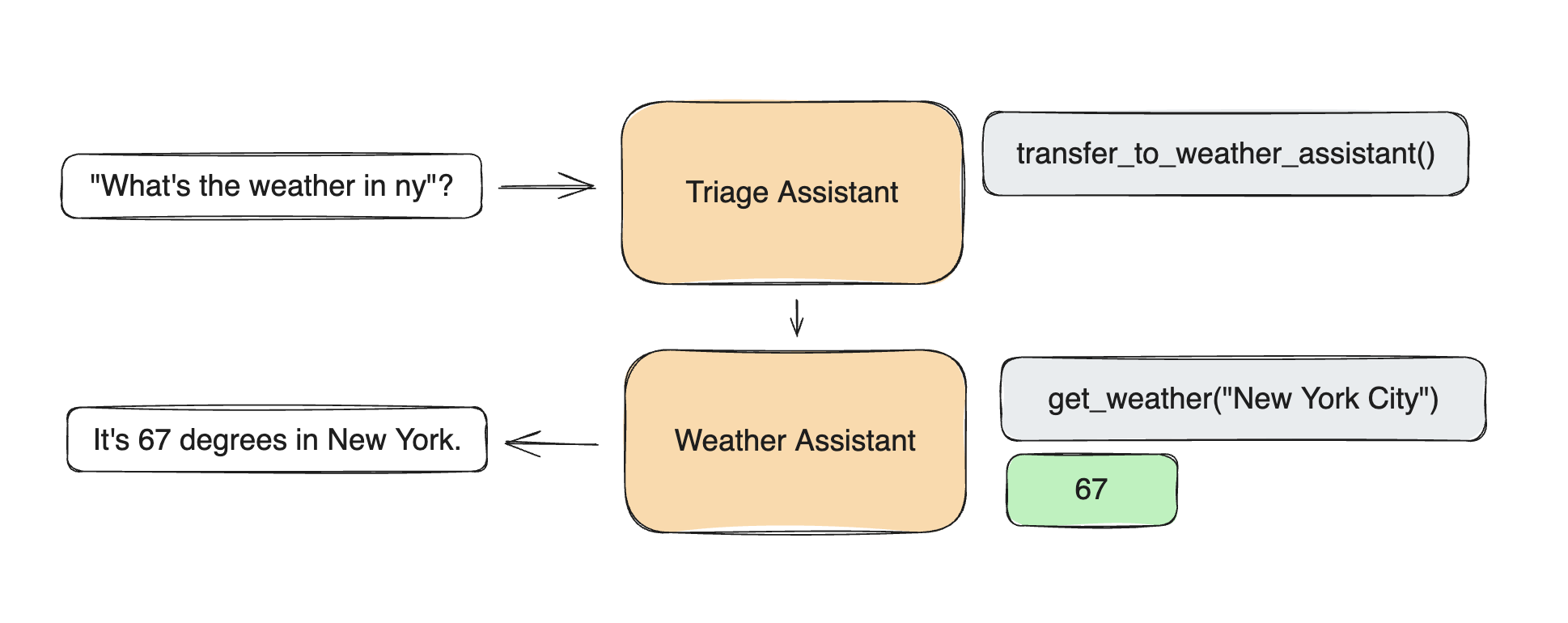A Ruby-based educational framework adapted from OpenAI’s Swarm, exploring ergonomic, lightweight multi-agent orchestration.
The primary goal of Swarm is to showcase the handoff & routines patterns explored in the Orchestrating Agents: Handoffs & Routines cookbook. It is not meant as a standalone library, and is primarily for educational purposes.
example_airline.mp4
Add this line to your application's Gemfile:
gem "ruby-openai-swarm"And then execute:
$ bundle installOr install with:
$ gem install ruby-openai-swarmand require with:
require "ruby-openai-swarm"For a more robust setup, you can configure the gem with your API keys, for example in an openai.rb initializer file. Never hardcode secrets into your codebase - instead use something like dotenv to pass the keys safely into your environments.
OpenAI.configure do |config|
config.access_token = ENV['OPENAI_ACCESS_TOKEN']
endOR
# https://openrouter.ai
OpenAI.configure do |config|
config.access_token = ENV['OPEN_ROUTER_ACCESS_TOKEN']
config.uri_base = "https://openrouter.ai/api/v1"
endmore see: https://github.com/alexrudall/ruby-openai/tree/main?tab=readme-ov-file#ollama
Then you can create a client like this:
client = OpenAISwarm.new
def spanish_agent
OpenAISwarm::Agent.new(
name: "Spanish Agent",
instructions: "You only speak Spanish.",
model: "gpt-4o-mini"
)
end
transfer_to_spanish_agent = OpenAISwarm::FunctionDescriptor.new(
target_method: :spanish_agent,
description: 'Transfer spanish speaking users immediately.'
)
english_agent = OpenAISwarm::Agent.new(
name: "English Agent",
instructions: "You only speak English.",
model: "gpt-4o-mini",
functions: [transfer_to_spanish_agent]
)
messages = [{"role": "user", "content": "Hola. ¿Como estás?"}]
response = client.run(agent: english_agent, messages: messages, debug: true)
pp response.messages.last{"role"=>"assistant",
"content"=>"¡Hola! Estoy bien, gracias. ¿Y tú?",
"refusal"=>nil,
:sender=>"Spanish Agent"}Setting ACCESS_TOKEN for AI Providers in examples
-
For OpenRouter:
OPEN_ROUTER_ACCESS_TOKEN=cxxxxxorexport OPEN_ROUTER_ACCESS_TOKEN=cxxxxx -
For OpenAI:
OPENAI_ACCESS_TOKEN=cxxxxxorexport OPENAI_ACCESS_TOKEN=cxxxxx
Check out /examples for inspiration! Learn more about each one in its README.
-
basic: Simple examples of fundamentals like setup, function calling, handoffs, and context variables- running:
ruby examples/basic/agent_handoff.rb - running:
ruby examples/basic/bare_minimum.rb - running:
ruby examples/basic/context_variables.rb - running:
ruby examples/basic/function_calling.rb - running:
ruby examples/basic/simple_loop_no_helpers.rb
- running:
-
triage_agent: Simple example of setting up a basic triage step to hand off to the right agent- running:
ruby examples/triage_agent/main.rb
- running:
-
weather_agent: Simple example of function calling- running:
ruby examples/weather_agent/agents.rb
- running:
-
airline: A multi-agent setup for handling different customer service requests in an airline context.- running:
DEBUG=1 ruby examples/airline/main.rb
- running:
-
support_bot: A customer service bot which includes a user interface agent and a help center agent with several tools -
personal_shopper: A personal shopping agent that can help with making sales and refunding orders
link: https://github.com/openai/swarm/tree/main?tab=readme-ov-file#examples
After checking out the repo, run bin/setup to install dependencies. Then, run rake spec to run the tests. You can also run bin/console for an interactive prompt that will allow you to experiment.
To install this gem onto your local machine, run bundle exec rake install. To release a new version, update the version number in version.rb, and then run bundle exec rake release, which will create a git tag for the version, push git commits and tags, and push the .gem file to rubygems.org.
Bug reports and pull requests are welcome on GitHub at https://github.com/graysonchen/ruby-openai-swarm. This project is intended to be a safe, welcoming space for collaboration, and contributors are expected to adhere to the code of conduct.
The gem is available as open source under the terms of the MIT License.


